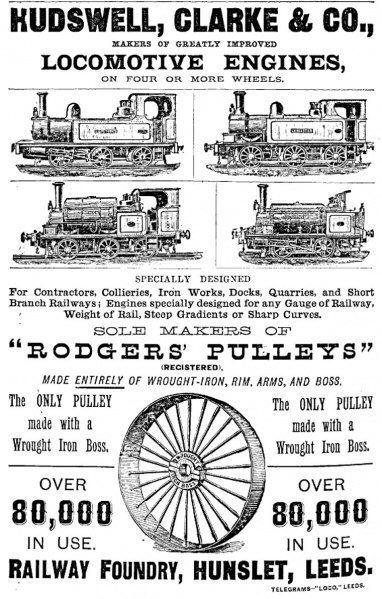 | ||
Hudswell clarke 1026 1913
Hudswell, Clarke and Company Limited was an engineering and locomotive building company in Jack Lane, Hunslet, Leeds, West Yorkshire, England.
Contents
- Hudswell clarke 1026 1913
- hd gwili railway 30 08 11 with hudswell clarke jennifer
- History
- Diesel locomotives
- Steam outline diesel locomotives
- Military engineering
- Preservation
- References
hd gwili railway 30 08 11 with hudswell clarke jennifer
History
The company was founded as Hudswell and Clarke in 1860. In 1870 the name was changed to Hudswell, Clarke and Rogers. There was another change in 1881 to Hudswell, Clarke and Company. The firm became a limited company in 1899.
In 1862, soon after the company had been formed, they were given the initial design work on William Hamond Bartholomew's compartment boats for the Aire and Calder Navigation. The choice of the company may have been influenced by the fact that Bartholomew, the chief engineer for the Navigation, and William Clayton, one of the founders of Hudswell and Clarke, both lived on Spencer Place in Leeds. They produced at least one of the prototype Tom Pudding compartments, but did not get the main contract for their production once the design work had been done.
The locomotive part of the business is now part of the Hunslet Engine Company. Locomotive-building was always only one part of a diverse product inventory that included underground diesel-powered mining locomotives, hydraulic pit-props and related mining equipment.
In 1911 Hudswell Clarke entered into an agreement with Robert Hudson for the manufacture of narrow gauge locomotives. This arrangement produced sixteen standardised designs, designated 'A' to 'Q', which ranged from four-coupled (0-4-0) 5 hp engines to six-coupled (0-6-0) 55 hp models. The designs were sufficiently flexible to allow for the various track gauges in use. Over the years, 188 locomotives were supplied to these designs.
In the 1930s the company manufactured narrow gauge steam outline diesel-hydraulic locomotives for use at amusement parks around the country. In 1931 4-6-2 Neptune was delivered to Scarborough North Bay Railway, followed a year later by 4-6-2 Triton, both being 20 inches (510 mm) gauge. In the same year they supplied a 4-6-4T Robin Hood to Golden Acre Park in Leeds followed by a 4-6-2 May Thompson in 1933. They also supplied 4-6-2 Mary Louise and 4-6-4T Carol Jean to Blackpool Pleasure Beach for use on the 21 inches (530 mm) gauge Pleasure Beach Express in 1933. A fire in 1934 badly damaged Carol Jean so 4-6-2 Princess Royal was ordered as a replacement. They went on to build two more 4-6-2 class locomotives, Princess Elizabeth and Princess Margaret Rose for Billy Butlin to use at the Empire Exhibition in Glasgow in 1938 which were then transferred to his holiday camp in Clacton when the exhibition closed.
In later years, Hudswell Clarke designed and built diesel locomotives for both main-line and private company use, mainly for use on shunting operations.
Diesel locomotives
Steam-outline diesel locomotives
Military engineering
During the Second World War the company diversified into armaments, as did so many other engineering companies. In the post-war period Hudswell, Clarke and Co Ltd was closely involved in various secret programmes, including the British nuclear weapon programme. The airframe for the first British nuclear bomb, Blue Danube was manufactured by Hudswell Clarke at its Roundhay Road, Leeds, plant. The airframe for Red Beard, the second generation tactical nuclear bomb, followed with that for Violet Club, the Interim Megaton Weapon; and there were many other projects. All the bombs detonated at the Christmas Island H-bomb tests were contained in airframes designed and built by Hudswell Clarke. The company were also major contributors to other military projects, e.g. the Centurion main battle tank conversion into an armoured bridgelayer, that served with the British Army for many years. The contraction of defence manufacturing in the mid-1960s contributed to the sale and demise of the company.
Preservation
Locations of preserved Hudswell Clarke locomotives include:
